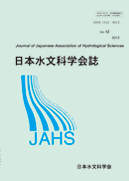All issues

Volume 41 (2011)
- Issue 4 Pages 113-
- Issue 3 Pages 47-
- Issue 2 Pages 27-
- Issue 1 Pages 1-
Volume 41, Issue 4
Displaying 1-3 of 3 articles from this issue
- |<
- <
- 1
- >
- >|
RESEARCH NOTE
-
Seiichiro IOKA, Norio TASE2011 Volume 41 Issue 4 Pages 113-129
Published: 2011
Released on J-STAGE: June 30, 2012
JOURNAL FREE ACCESSThe long-term protection of the world's groundwater resources partially depends on the ability of aquitards to retard the movement of natural and anthropogenic solutes, and hence, it is important to understand the processes controlling the distribution, transport, and attenuation of dissolved materials. Moreover, the consequences of increasing amounts of anthropogenic N circulating in groundwater is of concern, and the attenuation and transport processes of NO3- present in the groundwater in aquitards must be examined. We have investigated the lateral distributions of NO3- concentrations in groundwater in an aquitard (4 m × 6 m area) at Tsukuba upland at a few meter-scales and attempted to identify the possible mechanisms for their heterogeneity; this, to our knowledge, is the first such study. High-resolution measurements were obtained using piezometers, and they revealed complex lateral NO3- heterogeneity. Large variations in the NO3- concentrations were found between groundwater samples from piezometers that were horizontally separated by a distance of as little as 2 m. Although the mechanism of lateral NO3- heterogeneity in the aquitard remained unclear, we believe that the occurrences of biochemical reactions such as denitrification and other factors such as the spatial variability of NO3- transport play a role in it. This first study of the meter-scale lateral heterogeneity of NO3- concentrations of groundwater in aquitards provides new insights into the mechanisms of natural attenuation of NO3- in aquitards; further, our study also discusses difficulties in some of the upscaling approaches of the NO3- natural attenuation zone in groundwater based on the data obtained from a small number of piezometers.View full abstractDownload PDF (2160K)
SUPPLEMENT
-
Atsushi YAMAKI2011 Volume 41 Issue 4 Pages 131
Published: 2011
Released on J-STAGE: June 30, 2012
JOURNAL FREE ACCESSIn vegetable fields in Shimousa plateau, a survey was carried out to find the state of nitrate nitrogen flowing out from the farmland. A measure was taken to decrease leaching of nitrogen with carrot cultivation, a major crop, and its effect was evaluated. (1) There were fields with large amount of residual nitrogen and concentrations of nitrate nitrogen were higher than the environmental standard at a depth of four meters after harvesting of vegetables. The data indicated that nitrogen leaching out from the farmland was likely to burden to groundwater. (2) The level of nitrate nitrogen in permeating water was inferred to exceed 15 mg/ L in surveyed fields from nitrogen balance. This calculation showed that a 23% cut of nitrogen input would decrease nitrate nitrogen in permeating water to 10 mg/L or less. (3) As a measure to diminish nitrogen by effective utilization of residual nitrogen, nitrogen input was decreased by 25% in a carrot field. As a result, the yield was comparable to conventional method.View full abstractDownload PDF (437K)
SERIES
-
4. Brines in Aizu district, western FukushimaMasaaki TAKAHASHI, Kohei KAZAHAYA, Masaya YASUHARA2011 Volume 41 Issue 4 Pages 133-139
Published: 2011
Released on J-STAGE: June 30, 2012
JOURNAL FREE ACCESSDownload PDF (2439K)
- |<
- <
- 1
- >
- >|